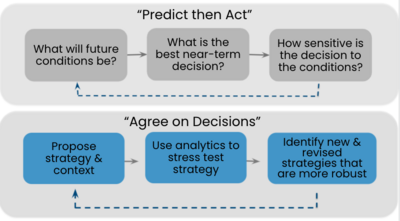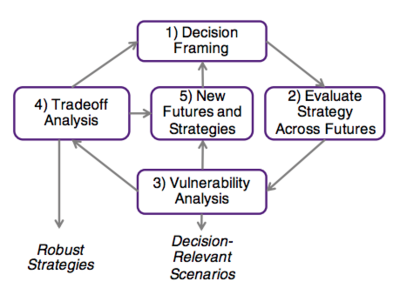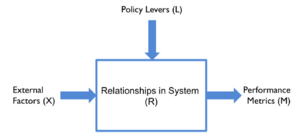Robust decision making
| Line 40: | Line 40: | ||
The simulations are build up on top of the previous described XLRM framework. The simulations give evaluation of the strategies by analysing how the models, R, performes over the different strategies, L, and uncertainties, X, giving an output of performance of each strategy according to the metrics, M, definded. <ref name="XLRM"/> The advange of running the simulations using the XLRM framework is that the model can be run as if it was a function: | The simulations are build up on top of the previous described XLRM framework. The simulations give evaluation of the strategies by analysing how the models, R, performes over the different strategies, L, and uncertainties, X, giving an output of performance of each strategy according to the metrics, M, definded. <ref name="XLRM"/> The advange of running the simulations using the XLRM framework is that the model can be run as if it was a function: | ||
| − | <math>M = f(X,L)</math> | + | <math>|right|M = f(X,L)</math> |
== Vulnerability analysis == | == Vulnerability analysis == | ||
Revision as of 12:23, 19 March 2022
Contents |
Abstract/introduction
Managing and planing projects or portfolios includes making big decision often based either on a very limited knowledge base, or an uncertain future - or both. Dealing with a great set of unknowns and uncertainties requires a skill set to make decisions making outcomes robust enough to cope unexpected futures and new disrupting knowledge. This is where Robust decision making proves its importance. Robust decision making (RDM) is a framework for decision making that take the uncertainty of different futures into consideration and helps the decision maker to reach his/her end goals by making decisions strong enough to fit a wider range of future scenarios. Rather then questioning the different future scenarios, the methodology of RDM focuses on what actions can be done at the present in order to improve future stands. Dealing with project, program and portfolio management, RDM is a vital methodology from the beginning where information can be limited, all the way to the end stage of a project where gained knowledge have the potential to disrupt previous made decisions.
This article will provide an all around description of what RDM is and how the methodolygy works. Additionally, the article will address a short background description of RDM, why RDM is so usefull as it is and where it differentiates from traditional risk management approaches. The thiery behind traditional risk management will not be thoroughly gone through.
History
As with many technologies and scientific approaches, RDM has its origin from military activities. In the early 1980's, when the Cold War was reaching its terminating, the RAND corporation was using simulation models designed to predict the potential outcome of different strategies. [1] At this stage of time, the methodology of RDM was not very well developed and RAND's predictions not very accurate. It was not until the early 1990's when the two RAND analysts Robert Lempert and Steven Popper further evolved the methodology framework in cooperation with RAND Computer Scientist Steve Bankes. The methods of RDM has been used ever since in an increasing manner on a wide range of different problematics of a very high degree of uncertainty including defense, flood risk management and climate change. [2]
RDM VS traditional risk management
The use of a traditional risk management approach can prove very effective and often bring good results. These approaches are limited though, as they only work well when uncertainty is well addressed. The methodology of traditional risk assessment comes in a number of different variations, but generally share a distinct pattern known as "predict-then-act". This approach follows the method illustrated in picture 1
RDM addresses the tendency of narrow-mindedness that traditional risk assessment can have. RDM "flips" the order of step in the "predict-than-act". As visualized in picture 1, the approach that RDM takes, often called the bottom-up analysis, starts by looking at the proposed strategies. The next step is to address the vulnerabilities of these strategies and access whether or not they meet the set goals. The third and final step is to alter the initial strategies identified in step one with respect to the vulnerabilities identified in the second step. These steps are iterated over a number of times until a robust strategy is reached.
Process of robust decision making: step-by-step
In this section, the different steps of the RDM process will be addressed. The section will give an insight in the process behind the methodology, and provide the background knowledge for the reader needed to perform simple step-by-step iterations of RDM. As RDM is made to solve very complicated problems with a high degree of uncertainty with potential outcomes counting hundreds if not thousands different futures, performing RDM in the scale it is made for, will require large simulation capacity.
Decision structuring
The first step of the iterative RDM process is the decision structuring, a deliberation step often done in collaboration with stakeholders. In this step, stakeholders gain a common understanding of the challenge their are facing, what are the objectives and success criteria, what measures can be done to pursue the identifies objectives under the number of uncertainties the problem statement is underlying. [1] [4]
In this step, the "XLRM framework" is used in order to properly identify and organize all of the factors identified from the stakeholders analysis, making sure a common understanding of the problem is reached. The XLRM framework consists of four elements:
XLRM Framework
The "XLRM framework" can be used to help properly identify and organize all of the factors identified from the stakeholders analysis, making sure a common understanding of the problem is reached. The XLRM framework consists of four elements: [4]
"X: Uncertain factors": Here uncertain factors that may intervene with the ability to reach the goals set is listed and described.
"L: Levers": The different "levers" of strategies policymakers can make and try to affect the outcomes of their strategies.
"R: Relationship": Is the relationship between the policy "levers" and uncertainties identified and how these relationships can affect the outcome of different futures.
"M: Metrics": Is the performance metrics or measures evaluating the outcomes and performances of strategies.
As illustrated in the picture to the right, the elements of uncertain factors, factors the stakeholder have no control of, and the identified policy levers collaborate to identify the relationships between the two, and from here, the metrics of the outcome of strategies can be assessed and potential measure to improve the outcome be defined. [5]
Strategy evaluation
The second step of RDM is the step for seeking agreement on decisions between the stakeholders. In this step, the different strategies are run and evaluated on simulations, going through the many plausible futures. The simulations will give an insight in how the plausible futures in perform in comparison to a set measure of success. [4] The simulations are build up on top of the previous described XLRM framework. The simulations give evaluation of the strategies by analysing how the models, R, performes over the different strategies, L, and uncertainties, X, giving an output of performance of each strategy according to the metrics, M, definded. [5] The advange of running the simulations using the XLRM framework is that the model can be run as if it was a function:

Vulnerability analysis
Tradeoffs
New futures and strategies
Annotated Bibliography
Contents:
1. History
2. Applications 3. RDM VS traditional risk management
Conditions of use Robust decision making Framework
3. Analytic tools
XLRM Framework
4. Limitations of Robust decision making 5. References
- ↑ 1.0 1.1 1.2 Vincent A. W. J. Marchau, Warren E. Walker, Pieter J. T. M. Bloemen, Steven W. Popper, "Desicion Making under Deep Uncertainty"
- ↑ Lembert, Robert; Popper, Steven; Banks, Steve; RAND, "ROBUST DECISIONMAKING (RDM)"
- ↑ https://toolkit.climate.gov/image/3273
- ↑ 4.0 4.1 4.2 https://www.rand.org/pubs/tools/TL320/tool/robust-decision-making.html
- ↑ 5.0 5.1 5.2 Kwakkel, Jan H.,"The Exploratory Modeling Workbench: An open source toolkit for exploratory modeling, scenario discovery, and (multi-objective) robust decision making"
Cite error: <ref> tag defined in <references> has no name attribute.